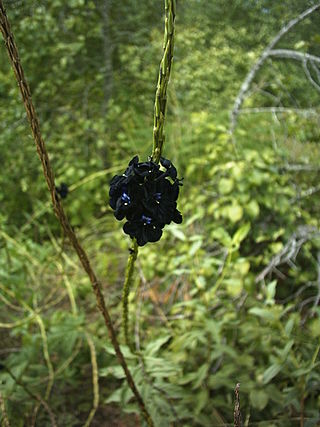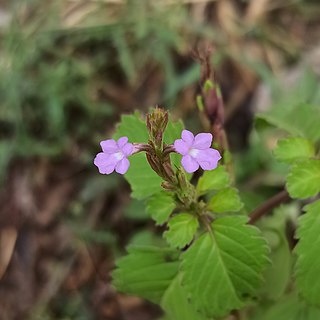
Myrtaceae, the myrtle family, is a family of dicotyledonous plants placed within the order Myrtales. Myrtle, pōhutukawa, bay rum tree, clove, guava, acca (feijoa), allspice, and eucalyptus are some notable members of this group. All species are woody, contain essential oils, and have flower parts in multiples of four or five. The leaves are evergreen, alternate to mostly opposite, simple, and usually entire. The flowers have a base number of five petals, though in several genera, the petals are minute or absent. The stamens are usually very conspicuous, brightly coloured, and numerous.

Leptospermum is a genus of shrubs and small trees in the myrtle family Myrtaceae commonly known as tea trees, although this name is sometimes also used for some species of Melaleuca. Most species are endemic to Australia, with the greatest diversity in the south of the continent, but some are native to other parts of the world, including New Zealand and Southeast Asia. Leptospermums all have five conspicuous petals and five groups of stamens which alternate with the petals. There is a single style in the centre of the flower and the fruit is a woody capsule.

Lantana is a genus of about 150 species of perennial flowering plants in the verbena family, Verbenaceae. They are native to tropical regions of the Americas and Africa but exist as an introduced species in numerous areas, especially in the Australian-Pacific region, South and Northeastern part of India. The genus includes both herbaceous plants and shrubs growing to 0.5–2 m (1.6–6.6 ft) tall. Their common names are shrub verbenas or lantanas. The generic name originated in Late Latin, where it refers to the unrelated Viburnum lantana.

Verbena, also known as vervain or verveine, is a genus in the family Verbenaceae. It contains about 150 species of annual and perennial herbaceous or semi-woody flowering plants. The majority of the species are native to the Americas and Asia; however, Verbena officinalis, the common vervain or common verbena, is the type species and native to Europe.

Kunzea is a genus of plants in the family Myrtaceae and is endemic to Australasia. They are shrubs, sometimes small trees and usually have small, crowded, rather aromatic leaves. The flowers are similar to those of plants in the genus Leptospermum but differ in having stamens that are longer than the petals. Most kunzeas are endemic to Western Australia but a few occur in eastern Australia and a few are found in New Zealand. The taxonomy of the genus is not settled and is complicated by the existence of a number of hybrids.

Baeckea is a genus of flowering plants in the myrtle family, Myrtaceae, all but one endemic to Australia. Plants in the genus Baeckea are shrubs or small trees with leaves arranged in opposite pairs, white to deep pink flowers with five sepals and five petals, and five to fifteen stamens that are shorter than the petals.

Asteromyrtus is a genus of flowering plants in the Myrtaceae family. It is closely related to Callistemon and Melaleuca.

Iresine is a genus of flowering plants in the family Amaranthaceae. It contains 20 to 25 species, all of which are native to the American tropics. The generic name is derived from the Greek word εριος (erios), meaning "wooly", referring to the trichome-covered flowers. Bloodleaf is a common name for those species that have colored foliage, and these are often cultivated as ornamental plants. Some species are additives to versions of the hallucinogenic drink ayahuasca.

Calothamnus is a genus of shrubs in the family Myrtaceae and is endemic to the south-west of Western Australia. The common names one-sided bottlebrush or claw flower are given to some species due to their having the flowers clustered on one side of the stem or because of the claw-like appearance of their flowers. Calothamnus species are generally medium to tall woody shrubs with crowded leaves. In most species the leaves are crowded and linear in shape, and the flowers are usually arranged in dense clusters. The petals are small and fall off the flower soon after it opens but the stamens are long, numerous and usually bright red.

Hypocalymma is a genus of evergreen shrubs in the myrtle family Myrtaceae described as a genus in 1840. The entire genus is endemic to southern Western Australia.

Stachytarpheta is a plant genus in the verbena family (Verbenaceae). The flowers are rich in nectar and popular with many butterflies, such as the South Asian crimson rose, Malabar banded swallowtail, and grass yellow Hummingbirds, especially small species like Lophornis coquettes, Chlorostilbon emeralds, and Discosura thorntails, are especially attracted for nectar. Several species in this genus are known as porterweeds.

Calytrix is a genus of shrubs in the family Myrtaceae described as a genus in 1806. They are commonly known as starflowers. Calytrix are endemic to Australia, occurring in the.
Johannes Conrad Schauer was a botanist interested in spermatophytes. He was born in Frankfurt am Main and attended the gymnasium of Mainz from 1825 to 1837. For the next three years he worked at the Hofgarten of Würzburg. Schauer then gained a position as assistant at the botanical garden at Bonn where he worked until 1832 when he was placed in charge of the botanic garden in Breslau, with C.G. Nees. He gained the degree of Doctor of Philosophy at the University of Erlangen-Nuremberg 1835 and was appointed professor of botany at the University of Greifswald from 1843 until his death in 1848.

Eduard August von Regel was a German horticulturalist and botanist. He ended his career serving as the Director of the Russian Imperial Botanical Garden of St. Petersburg. As a result of naturalists and explorers sending back biological collections, Regel was able to describe and name many previously unknown species from frontiers around the world.

Rinzia is a genus of flowering plants in the family Myrtaceae. The genus was first formally described in 1843 and reinstated and revised in 1986.

Nepetoideae is a subfamily of plants in the family Lamiaceae.
Tetrapora is a genus of flowering plants belonging to the family Myrtaceae.

Bouchea is a genus of flowering plant belonging to the family Verbenaceae.
Oxymyrrhine is a genus of flowering plants belonging to the family Myrtaceae.
Dryopetalon is a genus of flowering plants belonging to the family Brassicaceae.















